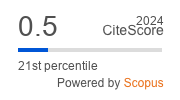CLINICAL AND MORPHOLOGICAL CHARACTERISTICS OF DISTURBANCES OF LOCAL IMMUNE RESPONSE IN ALOPECIA AREATA ACCORDING TO THE DISEASE ACTIVITY
Abstract
Aim. Description of morphological characteristics of alopecia areata according to the disease activity.
Methods. Skin biopsies from scalp of patients with alopecia areata were studied: expression of CD4+, CD8+, CD68+, interleukin-2 (IL-2), interferon-y (IFN-y) and tumor necrosis factor a (TNF-a) was assessed.
Results. In alopecia areata local inflammatory CD4+- and CD8+-mediated cytotoxic immune response develops with participation of proinflammatory cytokins (IL-2, IFN-y, TNF-a). Corellation between clinical and morphological signs of alopecia areata activity can be seen.
Conclusion. Local skin immune-mediated inflammatory response in alopecia areata can be considered as target for pathogenetic therapy.
About the Author
G. P. TereshchenkoRussian Federation
References
1. Адаскевич В.П., Мяделец О.Д., Тихоновская И. В. Алопеция. Медицинская книга. — Н. Новгород: Изд. НГМА, 2000. - 79 с.
2. Аллергология и иммунология: Клинические рекомендации / Под ред. Р.М. Хаитова, Н.И. Ильиной. — М: ГЭОТАР-Медиа, 2006. - 240 с.
3. Гаджигороева А.Г., Коган Е.А., Потекаев Н.Н. и др. Соотношение процессов апоптоза, пролиферации, неоангиогенеза и клеточной дифференцировки при имумунном воспалении в очагах гнездной алопеции / / Клин, дерматол. и венерол. — 2010. — №2 . -С . 23-31.
4. Суворова К.Н., Гаджигороева А.Г. Гнездная алопеция. Ч. 1: Этиология и патогенез / / Вести, дерматол. и венерол. - 1998. - № 5. - С. 67-73.
5. Bodemer С., Peuchmaur М., Fraitaig S. et al. Role of cytotoxicTcellsinchronicalopeciaareata// J. Invest. Dermatol.— 2000. - Vol. 114, N 1 ,- P. 112-116.
6. Brajac /., Gruber F., Petrovecki M., Malnar-Dragojevic D. lnterleukin-2 receptor alpha-chain expression in patients with alopecia areata / / Acta Dermatovenerol. Croat. — 2004. - Vol. 12, N 3. - P. 154-156.
7. Chodorowska G., Dabrowska-Czlonka M., Bartozinska I. el al. The immunological aspects of alopecia areata // Ann. Univ. Mariae Curie Sklodowska. — 2007. — Vol. LX 11, N 1. - P. 37.
8. Erne! D.C., Ekin S., Meltem U. el al. Investigation of the inflammatory mechanisms in alopecia areata / / Am. J. Dermatopatol. — 2009. — Vol. 31. — P. 53—60.
9. Gilhar A., Landau M., Assy B. et al. Mediation of alopecia areata by cooperation between CD4+ and CD8+ lymphocytes: transfer to human scalp explants on Prkdc(scid) mice //Arch. Dermatol. — 2002. — Vol. 138. — P. 916-922.
10. Gilhar A., Paus R., Kalish R.S. Lymphocytes, neuropeptides, and genes involved in alopecia areata / / J. Clin. Invest. — 2007. - Vol. 117, N 8. - P. 2019-2027.
11. Goh C., Finkel M., Cristos P.J. et al. Profile of 513 patients with alopecia areata: association of disease subtypes with atopy, autoimmune disease and positive family history // J. Eur. Acad. Dermatol. Venereol. — 2006. — Vol. 20. — P. 1055-1060.
12. Hibino T., Nishiyama T. Role of TGF-beta2 in the human hair cycle / / J. Dermatol. Sci. — 2004. — Vol. 35. — P. 9.
13. Kalish R.S., Gilhar A. Alopecia areata: autoimmunity — the evidence is compelling / / J. Investig. Dermatol. Symp. Proc. - 2003. - Vol. 8, N 2. - P. 164-167.
14. Katagiri K., Arakawa S., Hatano Y. In vivo levels of IL-4, IL-10, TGF-betal and IFN-gamma mRNA of the peripheral blood mononuclear cells in patients with alopecia areata in comparison to those in patients with atopic dermatitis // Arch. Dermatol. Res. — 2007. — Vol. 298, N 8. — P. 397-401.
15. Khalid Jameel, Amer Ejaz, Majid Sohail et al. Value of transverse section scalp biopsy in alopecia areata — a clinicopathological correlation / / J. Col. Physicans Surgeons Pakistan. - 2008. - Vol. 18, N 6. - P. 338-341.
16. McElwee K.J. et al. The pathogenesis of alopecia areata in rodent models / / J. Invest. Dermatol. Symp. Proc. — 2003. — Vol. 8. - P. 6.
17. Messenger A.G., Bleehen S.S. Expression of HLA-DR by anagen hair follicles in alopecia areata // J. Invest. Dermatol. - 1985. - Vol. 85. - P. 569-572.
18. Olsen E., Hordinsky M., McDonald-Hull S. et al. Alopecia areata investigational assessment guidelines. National Alopecia Areata Foundation // J. Am. Acad. Dermatol. — 1999. - Vol. 40. - P. 242-246.
19. O’Shea J., Ma A., Lipsky. Cytokines and autoimmunity // Nat. Rev. Immunol. - 2002. - Vol. 2. - P. 37-45.
20. Shapiro J., Madani S. Alopecia areata update / / J. Am. Acad. Dermatol. — 2000. — Vol. 42. — P. 549.
21. The in C., Strange P, Hansen ER., Baadsgaard O. Lesional alopecia areata T lymphocytes downregulate epithelial cell proliferation / / Arch. Dermatol. Res. — 1997. — Vol. 289, N 7. - P. 384-388.
22. Todes-Taylor N., Turner R., Wood G.S. et al. T cell subpopulations in alopecia areata / / J. Am. Acad. Dermatol. - 1984. - Vol. 11. - P. 216-223.
23. Tsuboi H., Tanei R., Fujimura T. et al. Characterization of infiltrating T cells in human sculp explants from alopecia areata to SCIP nude vise: possible role of the disappearance of CD8+ T lymphocytes in the process of hair regrowth // J. Dermatol. — 1999. — Vol. 26. — P. 797-802.
24. Whiting D.A. Histopathologic features of alopecia areata: a new look / / Arch. Dermatol. — 2003. — Vol. 139. — P. 1555-1559.






































